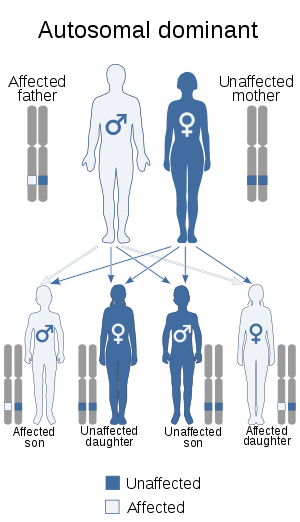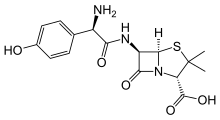Activated PI3K delta syndrome
| Activated PI3K delta syndrome | |
|---|---|
| Synonyms | immunodeficiency 14, p110δ-activating mutation causing senescent T cells, PASLI |
 | |
| Activated PI3K Delta Syndrome is autosomal dominant | |
| Symptoms | Immunodeficiency, Lymphadenopathy[1] |
| Causes | Mutation in phosphatidylinositol 4,5-bisphosphate 3-kinase catalytic subunit delta isoform[2][3] |
| Diagnostic method | Genetic testing[4] |
| Treatment | Antiviral therapy[5][6] |
Activated PI3K delta syndrome is a primary immunodeficiency disease caused by activating gain of function mutations in the PIK3CD gene.[7][8][2] Which encodes the p110δ catalytic subunit of PI3Kδ, APDS-2 (PASLI-R1) is caused by exon-skipping mutations in PIK3R1 which encodes for the regulatory subunit p85α. APDS and APDS-2 affected individuals present with similar symptoms, which include increased susceptibility to airway infections, bronchiectasis and lymphoproliferation.
Symptoms and signs
The signs and symptoms of activated PI3K Delta Syndrome are consistent with the following:[1]
- Immunodeficiency
- Lymphadenopathy
- Sinopulmonary infections
- Bronchiectasis
Cause
In terms of genetics, activated PI3K Delta Syndrome is autosomal dominant, a mutation in phosphatidylinositol 4,5-bisphosphate 3-kinase catalytic subunit delta isoform is the reason for this condition (located at chromosome 1p36.) [2][3]
Mechanism

The pathophysiology of activated PI3K delta syndrome has several aspects.[2] The normal function has P110δ(PI3K) involved in immune system regulation.[9]
P110δ effect is not limited to the immune system; P110δ has a presence in transformed epithelial cells and cell adhesion molecules (airway inflammation), and research has been done on the possibility of P110δ in the nervous system.[10]
Activated PI3K delta syndrome effect indicates affected individuals are likely to have activation-induced cell death.[2] Normally, PI3K-delta signaling assists B cells and T cells to mature; however, overactive PI3K-delta has an effect on the B and T cell differentiation (the process by which cells eventually are different from one another[11]).
Consequently there is an inability to confront an infection, as well as early cell death. Furthermore, overproduction of said signal can cause lymphadenopathy (which is an enlargement of lymph nodes[12]) due to excess white blood cells.[7]
Diagnosis
In order to ascertain if an individual has activated PI3K delta syndrome, usually one finds atypical levels of immunoglobulins. Methods to determine the condition are the following:[4]
- Genetic testing
- Laboratory findings
- Symptoms exhibited
Treatment

Infections for this condition, are treated or prevented in the following general ways:[5][6]
- Bacterial infection should be treated rapidly(with antibiotics)
- Antiviral therapy
- Modify lifestyle (exposure to pathogens need to be minimized)
See also
References
- 1 2 "PASLI disease | Genetic and Rare Diseases Information Center (GARD) – an NCATS Program". rarediseases.info.nih.gov. Retrieved 2017-06-09.
- 1 2 3 4 5 "OMIM Entry - # 615513 - IMMUNODEFICIENCY 14; IMD14". www.omim.org. Retrieved 2017-06-10.
- 1 2 Reference, Genetics Home. "PIK3CD gene". Genetics Home Reference. Retrieved 2017-06-10.
- 1 2 "PI3 Kinase Disease | NIH: National Institute of Allergy and Infectious Diseases". www.niaid.nih.gov. Retrieved 2017-06-10.
- 1 2 "Immunodeficiency (Primary and Secondary). Information". patient.info. Retrieved 2017-06-11.
- 1 2 "Bronchiectasis Treatment & Management: Approach Considerations, Supportive Treatment, Antibiotic Therapy". 2017-02-17.
- 1 2 Reference, Genetics Home. "activated PI3K-delta syndrome". Genetics Home Reference. Retrieved 2017-06-09.
- ↑ Collard, Harold R.; Richeldi, Luca (2017-02-18). Interstitial Lung Disease E-Book. Elsevier Health Sciences. p. 9. ISBN 9780323480253.
- ↑ "PIK3CD phosphatidylinositol-4,5-bisphosphate 3-kinase catalytic subunit delta [Homo sapiens (human)] - Gene - NCBI". www.ncbi.nlm.nih.gov. Retrieved 2017-06-11.
- ↑ Schoenberger, Stephen P.; Katsikis, Peter D.; Pulendran, Bali (2015-08-31). Crossroads Between Innate and Adaptive Immunity V. Springer. p. 121. ISBN 9783319157740.
- ↑ Prasad, Keder N. (2012-12-06). Regulation of Differentiation in Mammalian Nerve Cells. Springer Science & Business Media. p. 2. ISBN 9781468481129.
- ↑ Fleisher, Gary R.; Ludwig, Stephen (2010). Textbook of Pediatric Emergency Medicine. Lippincott Williams & Wilkins. p. 378. ISBN 9781605471594.
Further reading
- Arjunaraja, Swadhinya; Snow, Andrew L. (2015). "Gain-of-function mutations and immunodeficiency: at a loss for proper tuning of lymphocyte signaling". Current Opinion in Allergy and Clinical Immunology. 15 (6): 533–538. doi:10.1097/ACI.0000000000000217. ISSN 1528-4050. PMC 4672729. PMID 26406182.
- Okkenhaug, Klaus; Ali, Khaled; Vanhaesebroeck, Bart (2007). "Antigen receptor signalling: a distinctive role for the p110δ isoform of PI3K". Trends in Immunology. 28 (2–2): 80–87. doi:10.1016/j.it.2006.12.007. ISSN 1471-4906. PMC 2358943. PMID 17208518.
External links
| Classification | |
|---|---|
| External resources |